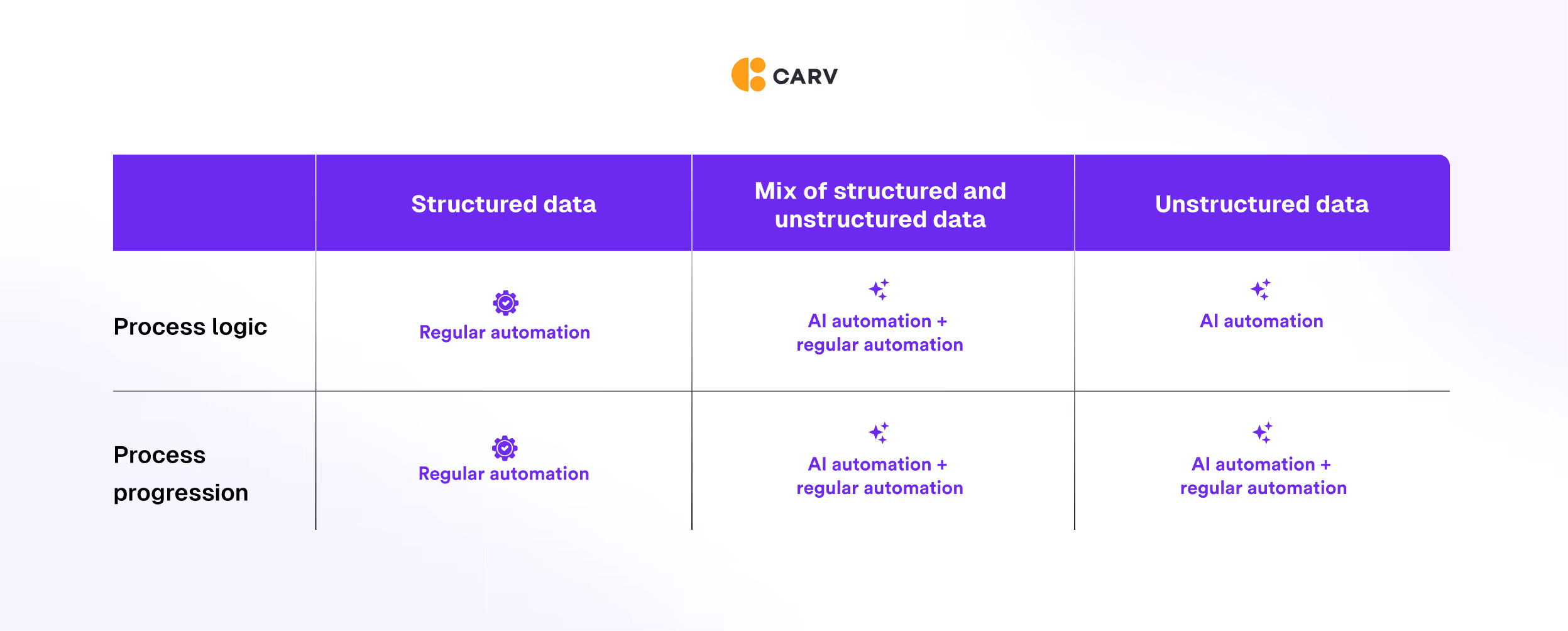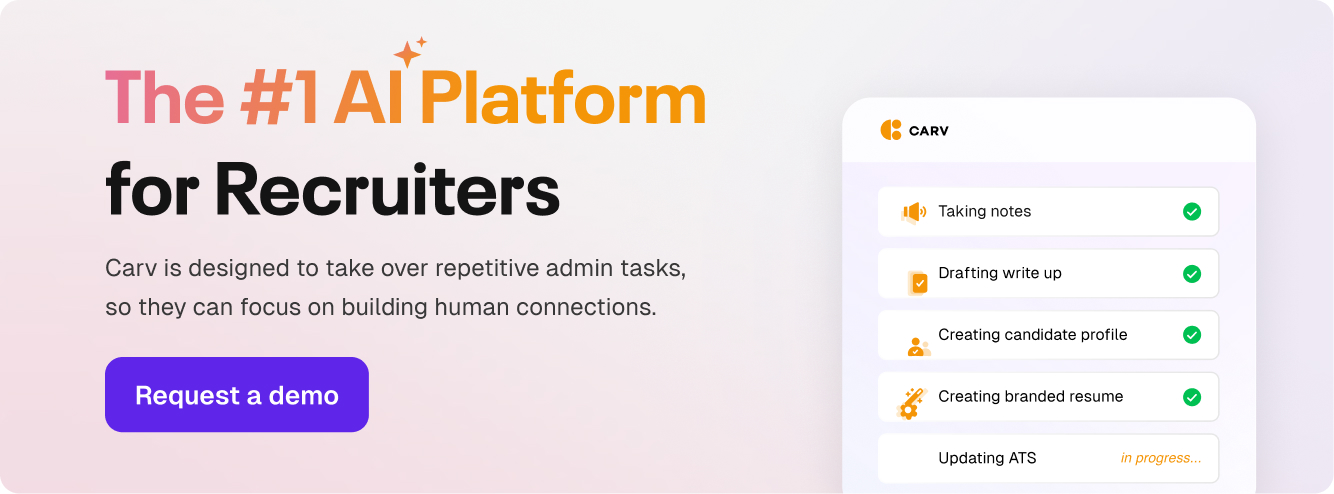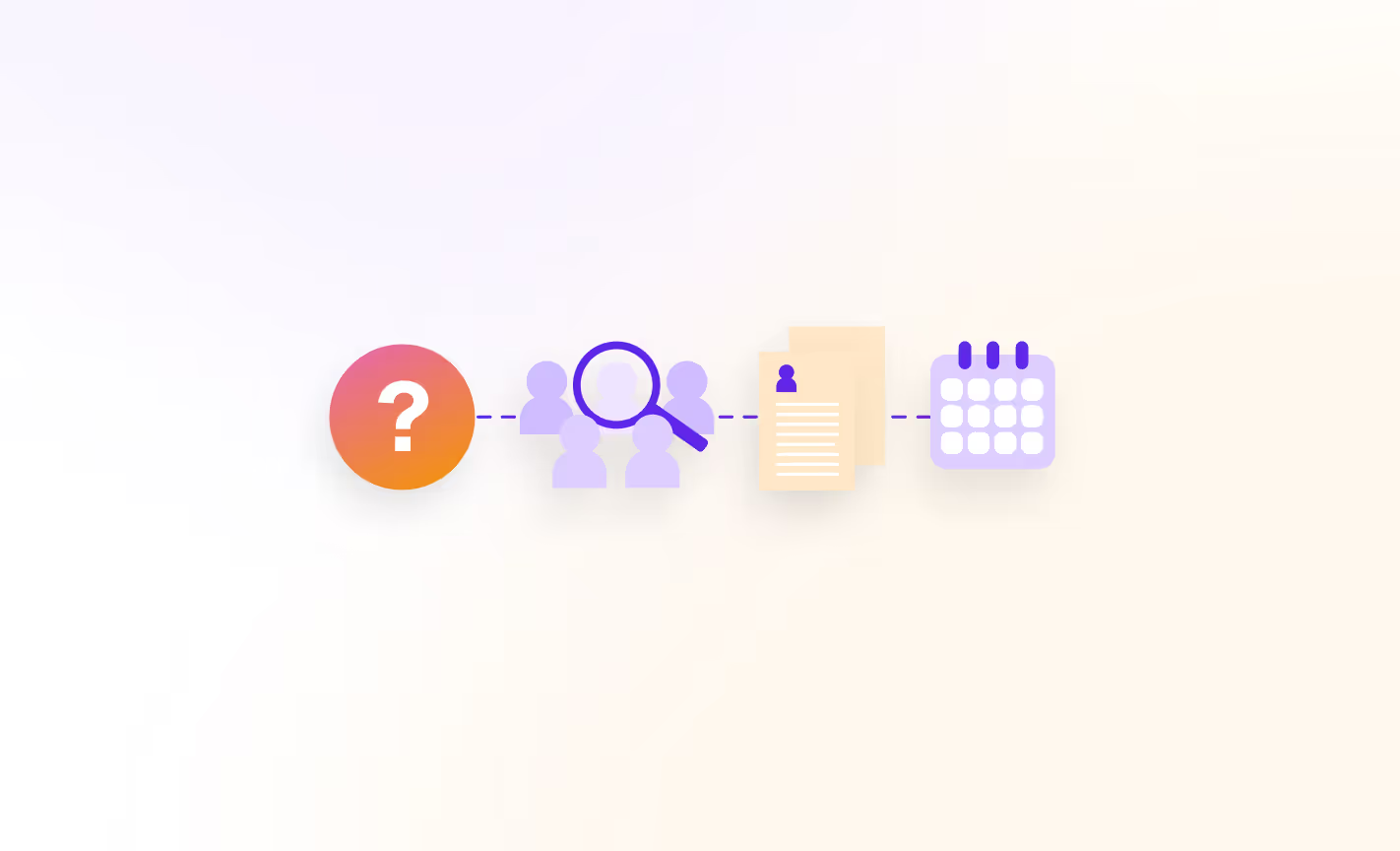The staffing industry thrives on human connection. When candidate and client relationships are managed properly, everything works smoothly: top talent gets matched with dream jobs, businesses flourish, and your agency becomes the go-to for placements.
But the reality for many staffing firms is that recruiters are buried under mountains of administrative tasks: sourcing channels to manage, resumes to scan, outreach emails to write, and interviews to schedule.
Our numbers show that, especially in smaller and mid-sized staffing and recruitment agencies, teams spend up to 30% of their time on repetitive admin tasks.
These tasks have the same type of input and output, repeated for each new candidate and client. The repetitive nature of these tasks is an issue not only because it leaves little room for work that drives placements and agency growth, but also because it’s a never-ending to-do loop that burns recruiters out.
After more than a decade in the HR tech space, we’ve decided to take advantage of advancements in generative AI to break this cycle and reshape the way staffing agencies operate.
Two types of admin tasks in agency recruitment
If we look at an agency recruiter’s typical day, there are two main types of tasks they focus on:
- Tasks that require real-time human intervention, such as candidate interviews, client intake calls, sourcing activities, biz dev work, and so on.
- Admin work: tasks that are repetitive in nature, rely on common inputs, and have standardized outputs. Some examples include screening resumes, writing job requirements, posting vacancies to job boards, or creating candidate profiles.
.avif)
Although there are automation solutions that could take over both types of tasks, the initiatives in the first bucket yield better outcomes when a human recruiter handles them in real time.
Think of interviews, for example: especially in white-collar jobs, candidates hate one-way interviews. This is not a secret.
Automated assessments with a limited number of questions might work in volume hiring—for example, for retail and call center roles—but they’re not ideal for roles that require more specialized skills. Thus, in niches like tech recruiting, healthcare, executive search, and so on, it’s preferable not to delegate the interviewing part to automation.
The tasks in the second bucket, though, are time-consuming, purely administrative, and don’t really require a real-time human touch. For example, pre-screening candidates, scheduling interviews, or sending follow-up emails—these can and should be automated to free up recruiters’ time.
Even tasks that seem more complicated at first sight, like writing job descriptions based on intake calls with hiring managers or creating candidate write-ups after an interview, can be delegated to AI.
Common approaches for recruitment automation
We’ve touched on this topic before, so I won’t go into too much detail, but I want to quickly highlight the difference between AI-based automation and regular automation before discussing AI implementation in recruitment.
When we refer to regular automation, we think of process steps such as advancing candidates in an ATS from one column to another, based on specific criteria. For example, candidates who are ready to start working within one month and have specific certifications or speak certain languages can be automatically moved to the next stage of the hiring process using regular automation software.
In the same way, sending outreach messages to job seekers on social media platforms can be automated using regular technology to speed up the staffing process.
Regular automation tools work with structured data: pairs of data fields such as the data type and the data value. You’ll recognize this structure from your ATS or CRM for sure.
However, tasks such as writing follow-up emails after an interview or intake call are more difficult to automate because interviews and calls are not structured. These meetings are unstructured data sources, and regular automation tools can’t handle them.

Generative AI tools, though, can work with unstructured data, as detailed here. So, gen AI tools can take over all the tasks in bucket two and automate them while adding personalization and the human touch as needed.
Moreover, a mix of regular and AI-driven automation can help agency recruiters fully optimize and streamline their recruitment processes for enhanced efficiency and effectiveness.
Now that this is clear, let’s look at how recruitment workflow automation can be approached.
In our talks with agency owners and recruiters, we see two trends taking shape:
- On one side, we have teams who want to automate but have limited budgets, so they try to build their own custom GPTs and create their own automated workflows using no-code databases as talent pools. In this scenario, what happens most of the time is that instead of simplifying things, these self-made solutions introduce more chaos and more admin without making an impact on the bottom line.
- At the other end of the spectrum, we see teams who are ready to invest, have the budget and the people for a full recruitment process transformation, but don’t have clarity on how to approach this. They lack a roadmap, clear goals, and a structured implementation framework, so they’re stuck in analyzing tools and planning transformation projects that often span several months.
While we do encourage talent acquisition professionals to fundamentally rethink their recruitment processes and workflows, we believe that the best approach is iterative: starting small, proving the impact of a solution, gaining buy-in from the team, and only then scaling and overhauling complete systems.
If you're curious to learn more about our view on this, you can read this article: Autonomous recruitment - What is it and how to get started.
%2520(1)%2520(1).avif)
Reducing admin by embedding AI in your core process
All right, what do we mean by “core process,” and what does starting small look like?
The core process in a staffing agency involves a well-defined sequence of steps:
- Job intake: Understanding client needs, defining the ideal candidate profile, and capturing key job requirements.
- Sourcing: Identifying and attracting qualified candidates through various channels.
- Screening: Evaluating resumes and cover letters to shortlist suitable candidates.
- Scheduling interviews: Coordinating candidate and client availability to find suitable interview times.
- Interviewing: Conducting in-depth interviews to assess skills, experience, and cultural fit, as well as following up with candidates and clients.
- Shortlisting & selection: Evaluating interview results and selecting the best candidate for the role.
- Offer & onboarding: Negotiating salary, extending an offer, and facilitating the onboarding process.
.avif)
While some steps, like interviewing and final selection, benefit from human judgment, AI can significantly enhance efficiency in most other stages. Here's how:
- Job intake: AI can analyze past placements and successful candidate profiles to suggest relevant candidate skills and desired experience for new job openings. AI can also extract job requirements from intake calls, write job descriptions, and publish vacancies on LinkedIn or other job boards.
- Sourcing: AI can scour vast online databases and social media platforms to identify potential candidates based on job requirements. Artificial intelligence can take over repetitive tasks such as finding candidates with specific experience or checking their social media profiles and enriching the profiles in your ATS or talent pool with data in specific formats.
- Screening: AI can scan resumes and cover letters, extracting key skills and qualifications to shortlist candidates who meet the criteria. AI technology can also handle screening calls, and chatbots can reach out to candidates via instant messaging to see if they’re available and interested by asking some knock-out questions.
- Communication: AI-powered tools can automate personalized outreach emails and schedule interviews based on candidate availability. Similarly, AI can handle follow-ups, write and send candidate write-ups to clients, or create personalized acceptance or rejection messages for candidates.
As for “starting small” and proving the impact first, let’s take Carv as an example and see how recruitment agencies can get started with AI.
Recruitment AI in action: How Carv can help
Carv is an AI solution purpose-built for recruitment teams. At its core, Carv does three things:
- Takes over the pure admin tasks occurring in the core recruitment process, including tasks like updating the ATS.
- Takes over candidate communication, from sourcing to hiring offer.
- Takes over the business development part, by finding clients and matching them with existing talent.
However, most staffing and recruitment agencies start with step one and delegate the core admin tasks to Carv: sourcing, screening, interview and intake follow-ups, and ATS updates.
In a typical recruitment tech stack, Carv sits right next to the ATS, but in a smaller or mid-sized agency, Carv can completely replace the ATS, as it serves as a library for all candidate data and communication.

In Carv, recruiters can store not only candidate resumes and profiles but also interviews and recordings of past screening calls. These contribute to a comprehensive candidate profile that’s more complete than the typical ATS candidate descriptions.
After embedding Carv into their workflows, the AI-driven recruitment process looks like this:
%2520(1).avif)
In this new reality, real-time human intervention is only required during the interview and intake call—all the other steps in the process are automated.
This approach enables teams to start experimenting with AI in their hiring process without overhauling their complete tech stacks and without requiring too high budgets.
The improvements are noticed almost immediately:
- Recruiters spend less time on repetitive, time-consuming tasks.
- The quality of candidate communications and engagement improves, as the AI is able to personalize at scale.
- Overall recruiting efficiency and effectiveness improve.
- Most importantly, teams learn how to collaborate with AI in a way that doesn’t feel disruptive. The AI workmates “behave” similarly to human recruiters, making the delegation of admin tasks effortless.
One thing to note is that the AI is customized to create specific outputs, mainly regarding the format of specific documents, but also when it comes to the tone of voice and formality level, as these vary from one client to another.
So how does Carv work under the hood?
The platform is integrated with the ATS, recruiters’ calendars, talent pool, and more, using custom AI agents to perform a variety of admin tasks, from contacting candidates for new vacancies to populating the ATS with candidate profiles.
.avif)
What does a recruiting firm need to do to get started with such a solution?
In short:
- Map their recruitment process. We've detailed the approach in this article: AI-driven recruitment - The before & after states of the recruitment process.
- Identify the tasks that could be delegated to AI and automated.
- Identify the types of inputs and outputs used for those tasks.
- Customize the Carv AI workmates before embedding artificial intelligence into hiring workflows. More on this, in an upcoming article.
In the meantime, if you’re curious to see Carv in action, you can book a demo below.



%20(1).avif)



%20(1).avif)
%20(1).avif)